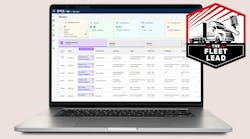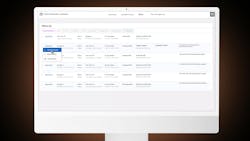Automation reshapes for-hire trucking—from tracking to rate negotiations
Key takeaways
- Automation is reducing manual tasks, allowing brokers and carriers to focus more on strategic relationships and business growth.
- Real-time shipment tracking has become a key industry expectation, supported by ELD mandates and mobile app adoption, improving visibility and customer satisfaction.
- The industry faces increased risks of cargo theft and fraud, prompting the development of identity verification and security technologies.
For-hire trucking is becoming more robotic.
Technology is changing how carriers, brokers, and shippers interact. Demand is growing for both real-time shipment tracking and the automation of several interactions.
“You’re seeing these technologies take over those transactional bits of relationships so that the broker and carrier relationships can become much more focused on the human and business elements, as opposed to the very operational and manual tasks,” Kary Jablonski, VP and GM of broker growth and Trucker Tools for DAT Freight & Analytics, told FleetOwner.
Mobile apps, artificial intelligence, load boards, and transportation management systems (TMS) are automating a range of manual tasks—from tracking to rate negotiation. However, the march toward automation is also followed by fraud.
Automation reshapes trucking operations—driving efficiency and new fraud risks
Logistics is still a relationship-driven industry, but the dynamics around those relationships are always changing. Throughout the last several years, online platforms have drastically changed the expectations that brokers and shippers have for their loads.
“Relationships are extremely important in this industry, whether that’s a shipper with a broker who doesn’t have any of their own trucks, or the shipper with the asset capacity providers … relationships are critical. That will never change,” Danielle Prigge, chief commercial officer at Mastery, told FleetOwner. “What has changed is how those relationships are managed throughout the day-to-day.”
According to DAT’s Jablonski, the rise of mobile apps a decade ago began to automate many of the interactions between parties.
“Mobile apps started to become a thing in 2012, 2013 in the trucking space to help carriers, especially small fleets, automate a lot of the manual processes they go through when working with brokers,” Jablonski said.
Over the last several years, demand for automation and real-time tracking has grown—but so has the risk of fraud.
Load tracking requirements
One of the most significant expectations is shipment visibility/load tracking. More than half of the shippers surveyed since the pandemic require real-time visibility of their loads.
Tracking adoption was supported by the electronic logging device (ELD) mandate from late 2017. An ELD in every vehicle meant that carriers and shippers could send automatic, real-time GPS location updates for significantly less hassle.
“We are seeing shippers demand more real-time visibility to where their freight is and when,” Prigge said.
“With Trucker Tools, we’ve seen tracking adoption, and using mobile devices to track, skyrocket over the last six to seven years,” Jablonski said.
One of the larger and more recent shipper surveys, the 2024 transportation benchmark survey by Descartes, found that the emphasis on freight tracking is still high. For the seventh consecutive year, visibility (42%) was ranked as the most important capability to manage transportation by 630 respondents.
Though still the highest-rated factor for several years, the importance of tracking among Descartes’s survey respondents dropped significantly in recent years. Tracking was the top answer for closer to 60% of shippers in 2020 and 2023. The company attributed this to a change in respondent makeup and a split between North American and European answers.
Most shippers (over 50%) said they used real-time tracking portals, direct TMS updates, or carrier/broker shipment status portals to track loads, but about 40% or more of respondents said they still used spreadsheets, emails, phone calls, and electronic data interchange (EDI).
Automated rate negotiations
Prigge said that rate visibility is becoming more important as well—and, with that, automated rate negotiations.
“We are seeing [shippers] demand more visibility to rates so that they can shop rates in a more digital way. And with that, you have some tech platforms available out there that can help manage that interaction between a capacity provider and the shipper, to say, ‘Here’s my lane. How much would you move it for?’ And then it can actually transact that freight at that point,” Prigge said.
It's not just shippers that are looking for easier interactions through tech platforms. Carriers also have the opportunity to spare their labor the tedious back-and-forth. Traditional processes take significant manual effort.
Carriers "are looking for the right loads. They’ll bid on a load on the DAT load board, for example, and then they’ll have to go back and forth via email, via phone, via text message; 10 years ago, it would have been via fax,” Jablonski said. “You go from finding a load to then bidding a load, going back and forth, hopping on a phone with a broker, getting an email confirmation, picking up the load, having to schedule over the phone, getting paid in a manual way, and then managing those documents quite manually.”
“With that comes a lot of use cases for things like RPA (robotic process automation) technology. You see a lot of organizations building bots scraping websites to see what freight shippers have available,” Prigge said. “That bot will then submit a rate based on pricing algorithms that the carrier has.”
The inescapable phrase "AI tools" is also finding its way into the load pricing landscape. More sophisticated than algorithmic bots, groups such as C.H. Robinson are using generative AI to provide price quotes, process orders, acquire trucking capacity, set appointments for pickup and delivery, and check on loads in transit.
“You’re seeing a lot of use cases for AI and agentic AI where shippers can go to a website and enter in that data,” Prigge said. “An AI agent will then run that interaction before ultimately handing it off to an actual customer service rep within that organization.”
From tracking to pricing and scheduling, automated tools are growing more pervasive for logistics relationships. Previously, menial tasks could require significantly fewer labor hours.
“There’s been this cultural acceptance of using our apps and phones to pass that information back and forth, which has made it a lot easier for carriers and brokers—as opposed to having to be on the phone or send an email,” Jablonski said.
The freight fraud boom
Accompanying the rise in automated interactions is the ease of fraud. Intuitively, if automation means brokers can give carriers a load without slow, menial human communications, then those brokers also have fewer chances to notice the red flags of a fraudulent operation.
Though an underreported crime, many agree that cargo theft in the U.S. has exploded since the pandemic. Common tactics include identity theft, double brokering, fictitious pick-ups, and more.
“A major theme in the post-COVID market is trust and safety. There has been a lot of cargo theft and fraud; carrier identities have been stolen,” Jablonski said.
As technology reduced human interactions, shippers’ desperation for carrier capacity during the pandemic also led to record-high rates and a weaker incentive to be picky among carriers. The subsequent freight downturn meant many spot market carriers had greater desperation for well-paying freight brokers. These circumstances gave fraudsters a golden opportunity lasting several years.
“Anytime there's an economic downturn or any major events across the country, you will see cargo theft tick up,” Scott Cornell, a transportation and inland marine crime and theft specialist for Travelers, said earlier this year. “I go back to the 2008 to 2010 market crash. We saw cargo theft blow up pretty good during that time and then came back down as the economy improved. This is a normal reaction that cargo thieves have. They take advantage of us when we're at our worst possible times.”
That does not mean technology always increases the risk of fraud. The Federal Motor Carrier Safety Administration’s plans for a registration overhaul will finally include identity verification technology. Several companies today are developing tools to shield carriers and brokers from fraud, including OTR Solutions, Highway, DAT, and many more.
This is part one of a two-part article series on logistics automation. Read part two here.
About the Author
Jeremy Wolfe
Editor
Editor Jeremy Wolfe joined the FleetOwner team in February 2024. He graduated from the University of Wisconsin-Stevens Point with majors in English and Philosophy. He previously served as Editor for Endeavor Business Media's Water Group publications.





